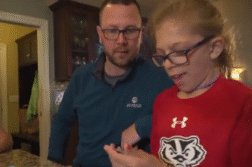CLEVELAND, Ohio. (Ivanhoe Newswire)—When your child is injured or ill, you want to find out what’s wrong as fast as possible and many times that will involve an x-ray or CT scan. But are those tests safe for your child? Can the radiation involved do more harm than good? Now, new Nobel-prize winning technology is changing the way your child will get scanned, making it smarter and safer scans.
From broken bones to something more serious, millions of children get an x-ray each year, but safety is a concern.
“Too much radiation certainly can increase your risk of cancer into adulthood. And I think patients are particularly susceptible when they are growing,” explained Michael Glotzbecker, MD, chief of pediatric orthopedics at UH Rainbow Babies and Children’s Hospital.
X-rays expose your child to less radiation than you get on an airplane flight. But about one in eight scans ordered for kids is a CT scan that takes multiple images and can deliver radiation doses that are up to 200 times higher than an average x-ray. Now doctors are working with the new EOS Edge x-ray technology that takes high resolution 3-d images with less radiation for safer scans.
“It’s really important for pediatric patients because it reduces the amount of radiation that you get compared to standard x-rays by almost 85 percent,” stated Dr. Glotzbecker.
Already used for adults, this technology can take two images, front and side at once and can turn those images into 3D.
“That’s really important when it comes to certain orthopedic conditions, particularly when we look at surgical planning,” Dr. Glotzbecker added.
The EOS Edge is being used in just a few children’s hospitals in the country right now, but technology like this is expected to become the standard of care in the near future.
Doctors say the expense and size of the machine are two factors that limit some hospitals from converting to the new technology. They say if your local children’s hospital does not yet have the technology, don’t be afraid to ask your healthcare provider if another test, which uses less radiation, could provide the same information for safer scans.
Contributors to this news report include: Cyndy McGrath, Executive Producer; Marsha Lewis, Field Producer; Kirk Manson, Videographer & Editor.
To receive a free weekly e-mail on Medical Breakthroughs from Ivanhoe, sign up at: http://www.ivanhoe.com/ftk
Sources:
https://www.fairview.org/patient-education/90457, http://imagegentlyparents.org/parents-need-know-orders-x-rays-scans-radiation-kids/
MEDICAL BREAKTHROUGHS
RESEARCH SUMMARY
TOPIC: EOS: GOODBYE TO X-RAYS, HELLO TO SAFER SCANS FOR KIDS!
REPORT: MB #4910
BACKGROUND: X-rays are a type of radiation called electromagnetic waves which creates pictures of the inside of the body. These pictures show the parts of the body in different shades of black and white because different tissues absorb different amounts of radiation. Calcium in bones absorbs x-rays the most and therefore, bones look white. Fat and other soft tissues absorb less and look gray. And air absorbs the least, so lungs look black. X-rays are typically used in checking for broken bones, but also used in other ways, like chest x-rays that can spot pneumonia, and mammograms that look for breast cancer. When you have an x-ray, you most likely wear a lead apron to protect certain parts of the body. The amount of radiation you get from an x-ray is small, like the amount of radiation you’re naturally exposed to from the environment over the course of 10 days.
(Source: https://medlineplus.gov/xrays.html)
RADIATION EXPOSURE: Radiation is around us all the time as we take in small amounts from the sun and other sources. People who live at high altitudes or who take many flights are around even more radiation exposure. However, in large doses, radiation can damage living tissue, alter DNA, and even cause severe sickness and death. Medical tests use much smaller doses of radiation. The main concern is that radiation exposure may slightly raise your child’s risk of cancer later in life. Some of this exposure might come from natural sources, but some of it can come from medical tests, like x-rays. New EOS imaging is a low-dose, weight-bearing x-ray technology that can simultaneously take full-body, front and side images of the skeletal system in a standing or sitting position. A typical EOS scan has a radiation dose equivalent to about one-third that of the dose of a conventional X-ray of the same body parts.
(Source: https://www.cedars-sinai.org/health-library/diseases-and-conditions—pediatrics/r/radiation-exposure-from-x-rays-in-children.html and https://www.hss.edu/condition-list_eos-imaging.asp)
NEW X-RAY DETECTION TECHNOLOGY: Researchers at Florida State University have developed a new material that could be used to make flexible X-ray detectors. These would potentially be less harmful to the environment and cost less than existing technologies. The team led by Biwu Ma, a professor in the Department of Chemistry and Biochemistry, created x-ray scintillators that use an environmentally friendly material. The team used the compound organic manganese halide to create scintillators that don’t use lead or heavy metals. The powder that is made performs very well for imaging and can be combined with a polymer to create a flexible composite that can be used as a scintillator. Ma said, “When you consider the ability to make flexible scintillators, it’s a promising avenue to explore.”
(Source: https://phys.org/news/2020-08-x-ray-technology.html)
FOR MORE INFORMATION ON THIS REPORT, PLEASE CONTACT:
KATELYN MCCARTHY
KATELYN.MCCARTHY@UHHOSPITALS.ORG
216-870-6321
If this story or any other Ivanhoe story has impacted your life or prompted you or someone you know to seek or change treatments, please let us know by contacting Marjorie Bekaert Thomas at mthomas@ivanhoe.com




